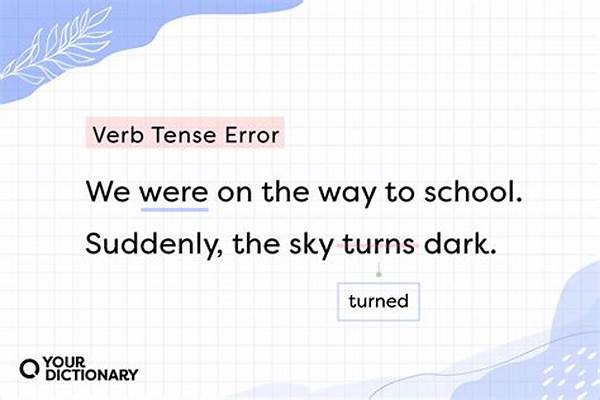Navigating the complex world of verb tenses can be challenging for language learners. Understanding the frequent verb tense mistakes novices make is crucial in improving their communication skills. Verb tenses help to convey the timing and the relationship of events, and they are often a stumbling block for beginners. Incorrect usage can lead to confusion and misunderstanding, making it essential for learners to identify and rectify these common errors.
Understanding Common Missteps
One of the frequent verb tense mistakes novices make is failing to distinguish between the simple past and present perfect. This misunderstanding often occurs when learners are unclear about whether an action was completed at a specific point in the past or if it has relevance to the present moment. Similarly, mixing up the future tenses can also be a source of confusion. Learners often find it difficult to choose between ‘will’ and ‘going to,’ as both can refer to future events. Additionally, incorrect tense sequencing in complex sentences can result in inaccurate context and timing relationships. These frequent verb tense mistakes novices encounter can hinder their progress and fluency in the language. By becoming aware of these common pitfalls, learners can focus their efforts on mastering the intricacies of tense usage.
Common Mistakes and Explanations
1. Confusing simple present and present continuous: Novices often interchange these tenses, using present continuous for routine actions instead of simple present.
2. Mixing up past simple and past continuous: Many learners struggle with when to employ ongoing past actions versus completed actions.
3. Errors in conditional sentences: Beginners often mishandle verb tenses in conditional forms, leading to confusion in meaning.
4. Incorrect use of future tenses: Novices frequently misuse ‘will’ and ‘going to,’ creating ambiguity in their intended meaning.
5. Overuse of present perfect: Novices may use the present perfect incorrectly when the simple past is more appropriate, leading to potential miscommunication.
Tips to Avoid Mistakes
Addressing the frequent verb tense mistakes novices make begins with a strong foundation of the basic rules governing verb tenses. Practice is key; regular exercises and writing prompts can help reinforce correct usage. It’s beneficial for learners to engage in conversations with native speakers, as this exposure allows them to hear and internalize proper tense usage within context. Additionally, keeping a language journal where learners can record sentences employing different tenses can aid in solidifying their understanding. Recognizing the importance of tense consistency is another critical step. When writing or speaking, maintaining consistent verb tense usage helps convey clear and precise meaning. Frequent verb tense mistakes novices make should be approached as learning opportunities, with each error serving as a stepping stone towards fluency.
Practical Applications and Examples
Real-life applications further illustrate frequent verb tense mistakes novices often encounter. When describing daily routines, beginners might say, “I am going to school every day,” instead of, “I go to school every day.” Another classic example is in narration, where a novice may say, “He was walking when he falls,” instead of using the past tense consistently. Similarly, expressing future intentions can also trip up beginners, leading to sentences like, “I will going to the store,” rather than “I will go to the store.” Regular practice with real-world examples helps novices understand the nuances of tense application, reducing errors over time.
Addressing the Challenges of Verb Tenses
Creating strategies to overcome these challenges can help mitigate the frequent verb tense mistakes novices face. For instance, sentence diagrams can be effective in visually breaking down sentences to analyze tense usage. Tools such as verb conjugation charts provide quick references and need to be readily accessible during writing or speaking exercises. Collaboration with fellow learners or tutors also fosters an interactive environment for spotting and correcting errors. By focusing on the frequent verb tense mistakes novices are prone to make, educators can tailor their teaching methods to cater to these specific needs, ensuring a comprehensive learning experience.
Keeping Up the Momentum
Consistency is the key to overcoming the frequent verb tense mistakes novices often encounter. Regular feedback from more experienced speakers, combined with constructive feedback mechanisms, can greatly enhance learning outcomes. Language apps and online resources offer numerous exercises specifically targeting tense usage, building learners’ confidence over time. It’s also imperative that learners embrace mistakes as an intrinsic part of the language acquisition journey. By breaking down the barriers of misunderstanding and cultivating a robust understanding of verb tenses, novices can pave the way for proficient and articulate expression.
A Balanced Approach to Mastery
In summary, tackling the frequent verb tense mistakes novices struggle with requires a multifaceted approach. A blend of theoretical knowledge and practical application forms the basis of comprehensive learning. Encouraging in-depth understanding of tense structures while promoting active usage within real-world contexts empowers learners to overcome obstacles. Mistakes should be embraced as valuable components of progress, providing insights into areas needing improvement. By fostering an environment that prioritizes growth over perfection, learners can steadily advance towards mastery, transforming challenges into opportunities for development.
